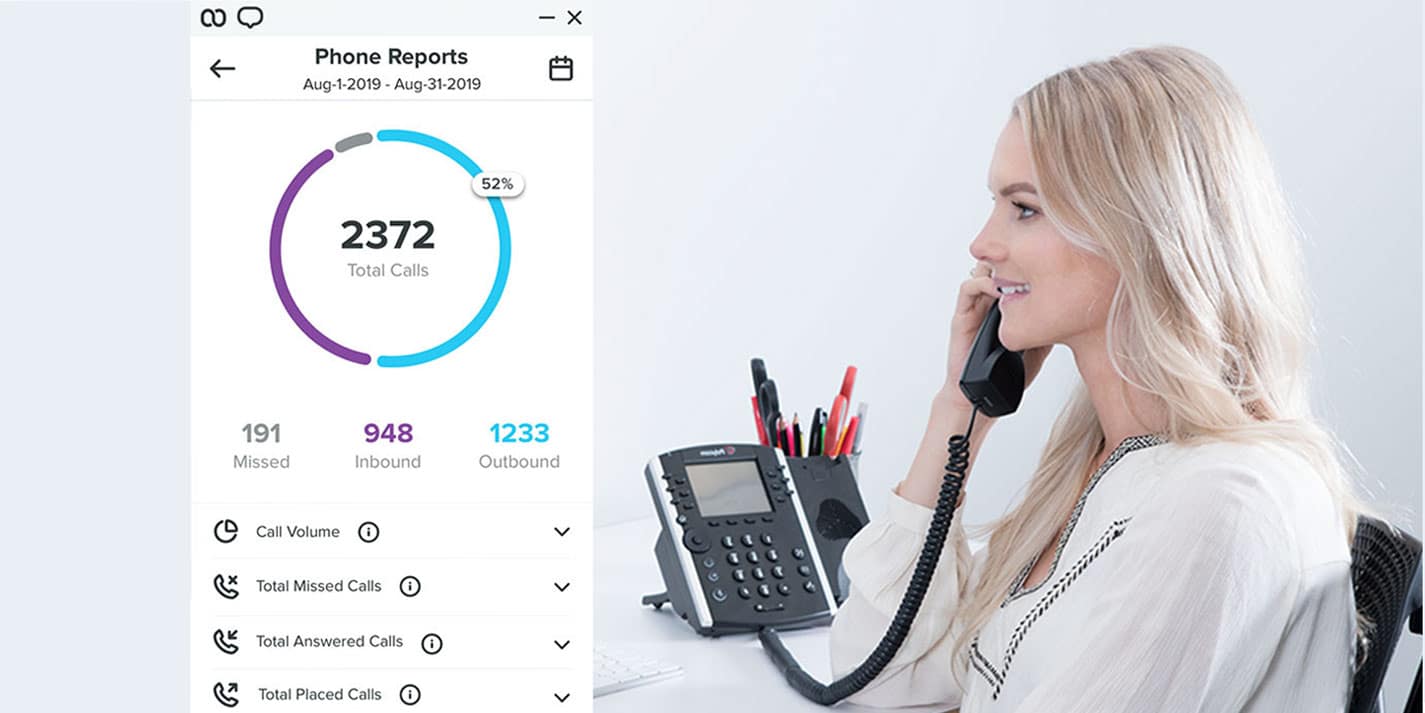You might be able to get away with a single phone line when your business is brand new, but as you add employees, you’re going to need a more professional solution.
Here’s the good news: enterprise-level functionality is now available to businesses of all sizes without an enterprise-level price tag. By installing a PBX phone system, you’ll be able to connect all of your business’s phones, even if they’re in separate locations.
Keep reading to discover how PBX phone systems can be a valuable asset to your small business.
What Is a PBX?
PBX is short for Private Branch Exchange. Its function is to manage both internal and external phone calls. The term “private” refers to the calls that are being managed within your organization, i.e., internal communications.
For example, if Employee A dials the extension for Employee B or for the receptionist, then the PBX would manage the call. This method is an alternative to an older way of call management in which the call would be routed out of the office and then back to Employee B. With a PBX, the phone communications remain internal, which is more efficient and potentially reduces costs (depending on your existing phone service).

A company’s PBX also interacts with the outside world through the PSTN (Public Switched Telephone Network) and VoIP, depending on your setup and the type of phone line the other person has. So, when you pick up your phone to dial a number outside your office network, the call first goes to your PBX. When the PBX realizes that the call isn’t meant to be delivered internally, then it will be routed through your phone provider, and then to its final destination.
Originally, PBX phone systems were developed for large companies to reduce their communications costs by giving them the ability to handle their own system routing for internal calls while utilizing the PSTN for outbound calls to locations outside the office. So, instead of paying for calls between employees on the same network, they would only have to pay for outgoing calls to people and businesses who are not at their location.
This configuration also protected the organization from high per-line fees because the PBX routed all of the outgoing calls from a single exchange, and there was no way for the phone company to know how many lines existed. So, instead of paying high per-line fees, the organization would only pay based on usage metrics like per-minute and long-distance charges.
While these factors can still be relevant, there are other reasons why a small business might want to have a PBX system. We’ll outline the benefits here.
How PBX Phone Systems Can Be an Asset to Your Small Business
As you can imagine, linking all of your internal phones together can cut costs while also improving your customer service. Here’s what you can expect when you adopt a PBX phone system:
Streamline Internal Communications
A PBX system helps keep everyone in your organization in easy and constant communication. Some of the features that enable this include call recording, voice mail, and ring groups.
If you’re not familiar with the term ring group, it’s a way of setting up rules for calls. For example, if a customer calls your phone number, do all of the extensions ring? Or, does only the receptionist’s line ring?
Ring groups also allow you to set up different rules based on the phone number that’s being dialed. For example, one phone number can ring the front office, another can be routed to customer service, and a third line can go to Accounts Payable or Accounts Receivable. The possibilities with this set up are virtually infinite.
how Weave
can help you?
Weave Helps Streamline Business Communication
"Amazing technology has simplified our {client} communication immensely! We are fairly new and can't wait to learn even more Weave features... customer service and tech support is SPOT ON and can't be beat! " - The Eye Station
Schedule DemoFlexible Call Routing
This feature also helps streamline communications while drastically improving customer service levels. Here’s how it works: Let’s say you’re an office manager at an optometrist’s office. You have a couple of administrative assistants in the office as well who are qualified to help clients, but it’s not their main role. They usually handle billing, records, and other data-driven tasks.
Though you’re the primary point person whenever the phone rings, you also have other responsibilities, including greeting clients and working side by side with the doctors on business and operational strategies. Because of this, you’re not always at your desk. With flexible call routing, the PBX system can automatically re-route a call to one of your backups if you don’t answer within a specified number of rings.
By re-routing calls, you can reduce the number of people who end up in voicemail boxes. Your bank account will also thank you because you won’t need to hire extra staff to handle the incremental calls.
Call Analytics

Having data about your phone calls can give you insights into productivity and potential abuse from unscrupulous employees. At a glance, you’ll be able to see how long employees are on the phone, who’s getting the most inbound calls, and how long the phone calls are lasting.
Using this information, you can establish benchmarks that can help standardize your metrics and give you solid KPIs moving forward.
Automate Incoming Communications
A PBX allows you to have an auto-attendant to greet callers and help them find the person or information they’re seeking. Callers can choose a variety of options to get information about your hours or location. Or, they can select the option to speak to a specific person or department.
Many systems now use IVR (interactive voice response) to allow callers to speak their commands and have the intelligent system understand their requests and fulfill their wishes.
Image Enhancement
Features like automated attendants are typically associated with larger, more established businesses. This sophisticated functionality signals to callers that you’ve invested in a quality phone system, and you’re committed to doing things the right way. When people call your office, they won’t get busy signals, staticky voicemails, or a phone that rings off the hook.
With modern PBX systems, your business can seem much larger than it is. Even if your team is just you and one other person, you’ll still be able to present a professional phone image without having to pay exorbitant fees.
Mobile Functionality
Today’s teams are no longer restricted to a single office location. They may work remotely once or twice a week, or travel as they serve your client base. Without a PBX, these employees have to rely on personal or company-issued cell phones to stay in communication. With a PBX system, your employees can use their mobile devices to access your company’s phone network.

As a result of this feature, your employees can make and receive calls from their smartphones as if they were still in the office. They’ll be able to access your business phone system features, including voicemail, ring groups, and call transferring no matter where they are.
PBX Phone System Options
A PBX can be located on-premise, in the cloud, or as a hybrid. On a side note, cloud-based PBX’s are no longer referred to as a PBX. Instead, they’re called Unified Communication solutions.
A PBX can handle calls from four different systems:
- Analog landlines
- Digital telephones
- VoIP (Voice over Internet Protocol)
- SIP (Session Initiation Protocol)
Each of these systems speaks its own language, so the PBX translates the signals so that the PSTN can understand the signals and connect the calls. The PBX can communicate either via a TSP (telecommunications service provider like AT&T, Verizon, etc.) or via an ISP (Internet service provider).
For small businesses with multiple lines, a PBX can reduce costs by sharing trunk lines between various phone stations. In plain terms, this means that instead of having to purchase ten trunk lines for each of the ten employees in your office, you can have each of the phones work with only one trunk line.
Local PBX Systems vs. Cloud PBX Systems
A local system means that the PBX is housed in your office. You’re responsible for 100% of the maintenance, which can be a challenge if you don’t have a full-time IT person on staff. For large companies like Microsoft, Qualcomm, or Google, paying a salary to technicians whose sole responsibility is keeping the phone system up makes sense, but for a small organization, it would be a colossal waste of funds.
A cloud-based PBX is much easier to manage because your phone service provider does all of the work. The provider sources, maintains, repairs, and updates all of the hardware. If something goes wrong, they’ll fix it. When you source a PBX phone system, make sure you’re familiar with the SLA (service level agreement), which specifies a commitment to uptime and how committed the provider is to 24-hour maintenance if there’s an issue.
By contrast, if you own the PBX hardware infrastructure, then you’ll have to maintain and repair it, install patches, replace hard drives, etc. For small businesses, a local PBX can be cost-prohibitive, so it’s usually better to choose a cloud-based PBX.
Conclusion
Have we piqued your curiosity about PBX phone systems? We invite you to schedule a live demo so you can see Weave in action.
